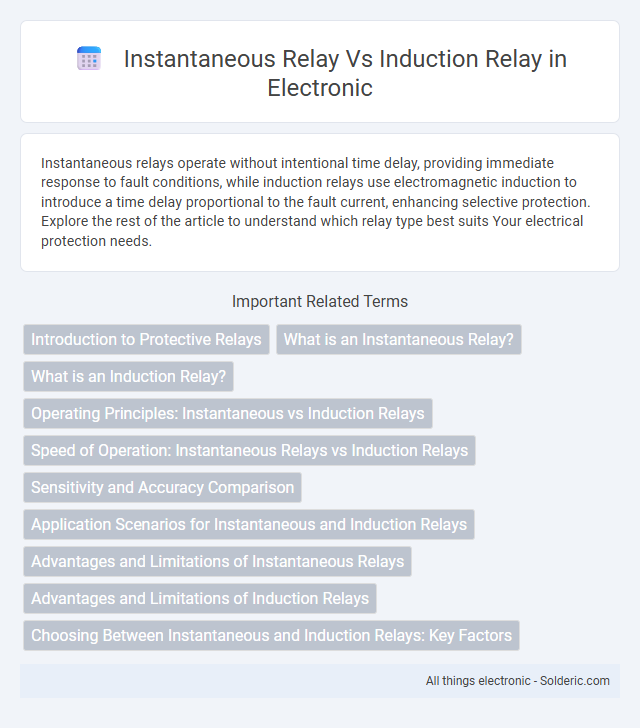Instantaneous relays operate without intentional time delay, providing immediate response to fault conditions, while induction relays use electromagnetic induction to introduce a time delay proportional to the fault current, enhancing selective protection. Explore the rest of the article to understand which relay type best suits Your electrical protection needs.
Comparison Table
| Feature | Instantaneous Relay | Induction Relay |
|---|---|---|
| Operating Principle | Operates immediately when current exceeds a set value | Uses induction principle; develops torque proportional to current |
| Operating Time | Instantaneous (0 - 0.01 seconds) | Delayed (typically 0.3 - 0.6 seconds) |
| Sensitivity | High sensitivity to fault currents | Moderate sensitivity |
| Application | Protection against short circuit faults | Overcurrent protection with time delay |
| Construction | Electromagnetic coil and armature | Rotating disc with shading coil |
| Reset Time | Immediate | Time delay due to disc inertia |
| Operating Characteristic | Fixed instantaneous operation | Inverse time or definite time characteristics |
| Cost | Less expensive | More expensive due to mechanical parts |
Introduction to Protective Relays
Instantaneous relays operate without intentional time delay, providing immediate tripping in protective devices, ideal for detecting severe faults. Induction relays use electromagnetic induction principles to introduce a time delay before activation, making them suitable for coordinating protection schemes. Your choice depends on the specific application requirements for speed and selectivity in electrical power system protection.
What is an Instantaneous Relay?
An instantaneous relay is a protective device designed to operate immediately upon detecting a fault current that exceeds a predetermined threshold, without any intentional time delay. It plays a critical role in electrical systems by providing rapid fault isolation to prevent equipment damage and ensure safety. Your choice of an instantaneous relay enhances system reliability by minimizing fault clearing time compared to induction relays, which rely on time-delayed electromagnetic mechanisms.
What is an Induction Relay?
An induction relay is an electromechanical protective device used in power systems to detect abnormal conditions like faults by responding to changes in current or voltage. It operates on the principle of electromagnetic induction, where currents induce a torque on a rotating aluminum disc, causing it to move and activate the relay contacts. Unlike instantaneous relays that respond immediately without intentional delay, induction relays provide time-delayed tripping, enhancing selectivity and coordination in electrical protection schemes.
Operating Principles: Instantaneous vs Induction Relays
Instantaneous relays operate by directly responding to current levels exceeding a preset threshold, triggering immediate trip actions without intentional time delays. Induction relays function based on electromagnetic induction principles, where a rotating disc's speed depends on the magnitude of current, introducing a time delay proportional to current intensity before tripping. Your protection system's choice between these relays depends on the need for either immediate fault clearance or time-delayed response to avoid nuisance tripping.
Speed of Operation: Instantaneous Relays vs Induction Relays
Instantaneous relays operate within milliseconds, providing ultra-fast response times essential for protecting electrical circuits from sudden faults. Induction relays have a slower speed of operation, typically ranging from fractions of a second to several seconds, due to their reliance on electromagnetic induction principles. Your choice between these relays should consider the critical need for speed in fault detection to ensure optimal system protection.
Sensitivity and Accuracy Comparison
Instantaneous relays offer high sensitivity by responding to fault currents without intentional time delays, making them suitable for fast protection but potentially prone to false trips from transient disturbances. Induction relays provide greater accuracy through their time-current characteristics, utilizing electromagnetic induction to differentiate between transient and sustained faults, thus enhancing selectivity in protection systems. Sensitivity of induction relays can be finely adjusted by controlling the damping and torque, resulting in precise operation tailored to specific fault conditions.
Application Scenarios for Instantaneous and Induction Relays
Instantaneous relays are ideal for protecting electrical circuits against short circuits and sudden faults due to their fast response time, making them commonly used in industrial motor protection and high-speed fault clearing. Induction relays, characterized by their inherent time delay and stable operation under fluctuating currents, suit applications such as overload protection in power systems, where gradual fault development or system stability assessment is crucial. Understanding the distinct application scenarios of instantaneous and induction relays helps you select the appropriate protection device to enhance system reliability and minimize equipment damage.
Advantages and Limitations of Instantaneous Relays
Instantaneous relays offer the advantage of extremely fast response times, typically within milliseconds, making them ideal for protecting electrical circuits from short-circuit faults. Their simple design and high sensitivity ensure reliable operation without delay, which minimizes equipment damage and improves system stability. However, the limitation lies in their inability to discriminate between transient faults and permanent faults, which may result in nuisance tripping and reduced selectivity in complex power systems.
Advantages and Limitations of Induction Relays
Induction relays offer advantages such as robustness, reliability in harsh environments, and the ability to provide time-delayed responses essential for selective coordination in power systems. However, they are limited by their mechanical nature, which causes wear over time, slower response compared to instantaneous relays, and less precision in operation. Your choice between instantaneous and induction relays will depend on the need for speed versus time delay in protective schemes.
Choosing Between Instantaneous and Induction Relays: Key Factors
Choosing between instantaneous and induction relays depends on the application's requirement for speed and selectivity in fault detection. Instantaneous relays provide rapid response without intentional time delay, ideal for protecting equipment from severe faults, while induction relays offer time-delayed operation based on the magnitude of current, which helps coordinate with other protective devices in the system. Evaluating factors such as fault current characteristics, necessary discrimination, and system coordination ensures optimal protective relay selection for reliable power system safety.
instantaneous relay vs induction relay Infographic

 solderic.com
solderic.com